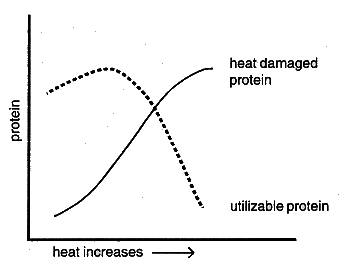| | Silage | How heat damage occurs | Effect on nutrition | Prevention of heat damage | Hay | Tests for heat damage | Adjusting for heat damaged protein
Silage
A well preserved, good quality silage is yellow-green to brown-green in colour with a clean vinegar-like odour. Heat damaged silage, however, is light to dark brown in colour with a distinct cured tobacco odour. These are some of the characteristics associated with heat damage that occur after the forage has been cut and stored in the silo. The damage is caused by overheating of the silage which decreases the availability of the protein to the animal and reduces the energy content of the feed.
How Heat Damage Occurs
The fermentation of silage occurs in two stages. During the first stage, oxygen trapped in the plant material is consumed by respiring plant cells and undesirable micro-organisms, producing heat. When all the oxygen is used, the plant cells and microbes that require oxygen cease to function. Under good conditions, this process is complete in one to two days.
In the second stage, bacteria, active in the absence of oxygen, grow and multiply and produce lactic acid, the acid responsible for the preservation and characteristic odour of good quality silage. When enough lactic acid is produced, fermentation ceases and preservation is complete.
The problem of heat damage usually occurs at the first stage. If the silo is not filled quickly, or is not adequately packed, excess oxygen is left in the silage. Plant respiration continues for an extended period of time resulting in more heat production than is desirable. If the temperature of the silage rises above 45°C (113°F), heat damage occurs. The higher the temperature, the greater the amount of damage.
Effect on Nutrition
At high temperatures, a chemical reaction occurs between the protein and carbohydrate present in the forage. This reaction, known as the browning reaction, is responsible for the characteristic cured tobacco odour and dark brown colour of heat damaged silage. Although cattle relish this kind of silage, its quality is reduced. Protein is denatured by this process and is unavailable for use by the animal.(See figure 1).

Prevention of Heat Damage Adjusting for Heat Damaged Protein
Depending on the extent of the damage, expensive protein supplementation may be required. Prevention is the best way to handle this problem. Following the basic rules for making good quality silage is the best way to minimize the potential for heat damage. Important considerations are:
- Wilt plant material to the correct moisture content (60-65% for bunker and pit silos).
- Chop length should not be too coarse. Chop dry forage finer than moist forage.
- Fill the silo quickly to minimize the amount of air introduced into the silo.
- Pack well to exclude air. Remember, the drier the plant material, the more difficult it is to pack.
- Cover the silage with plastic to minimize exposure to air at the surface. Secure the plastic with bales, tires, chopped forage, etc., to prevent rippling in the wind.
Hay
Heat damage also occurs in stored hay. At a high moisture content, heat is produced as a result of mold growth. If this heat is not dissipated quickly, the temperature of the forage rises.
When hay is baled or stacked at moistures above 25 percent, the temperature can rise to levels sufficient to initiate the browning reaction causing heat damage.
Hay stored in large bale systems appears to be more susceptible to heat damage because heat is dissipated more slowly than with conventional small bales. The risk of heat damage can be reduced by baling hay at a moisture content of 20 percent or less.
Tests for Heat Damage
Since heat damage does not change the amount of protein present in a feed, laboratory tests for protein do not detect the presence of heat damage. To determine if heat damage has occurred and how extensive the damage is, a test for heat damage must be done. The test used is known as acid detergent insoluble nitrogen, ADIN for short. Most laboratories can do this analysis.
Adjusting for Heat Damaged Protein
The protein content of forages that have been heat damaged should be adjusted to account for the reduction in usable protein.
Acid detergent fibre -- crude protein (ADF-CP) is a measure of crude protein unavailable to the animal. It is calculated from ADF-N or ADIN.
Adjusted or available crude protein (ACP) is the CP available for animal use. It is calculated when the ADF-CP is greater than 10% of the tested CP in a feed sample.
For example, a lab report contains the following information:
Crude Protein 12.1%
ADIN 0.42%
Step 1
Calculate ADF-CP from ADIN
ADF-CP% = | ADIN% x 6.25 |
2.63% = | 0.42 x 6.25 |
Step 2
Calculate ADF-CP as a percentage of the total CP
ADF-CP, % of total CP = | ADF-CP% |  |
| x 100 |
CP% |  |
 |  |  |
21.69% = | 2.63% |  |
| x 100 |
12.1% |  |
Note: 21.69% > 10% of total CP; therefore, calculate ACP.
Step 3
Calculate Adjusted CP (ACP)
ACP% of DM = |  |
| CP% x [100 - (ADF-CP% of total - 10%] |
|
100 |
ACP% of DM = |  |
| 12.1% x [100 - (21.7% - 10%)] |
|
100 |
= | 10.7% |
Therefore, rations should be formulated using 10.7% as the protein content of the forage.
Note: If ADF-CP is 10% or less of CP then ACP = CP and there is no need for adjustment.
Adapted from Alberta Agriculture Beef Herd Management Reference Binder and Study Guide - 307 |
|